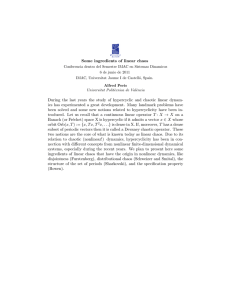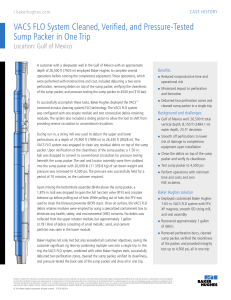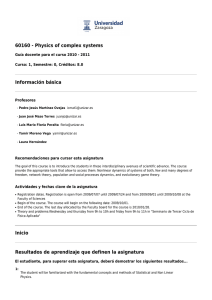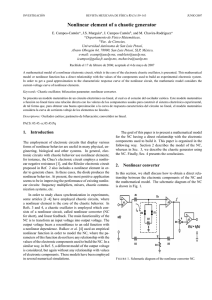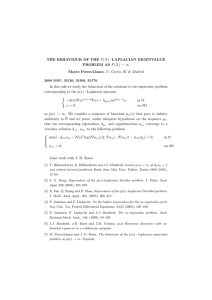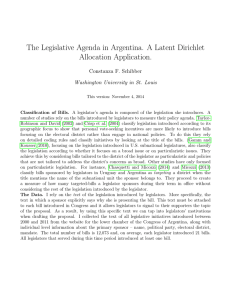Results on Existence of Solution for an Optimal Design Problem
Anuncio
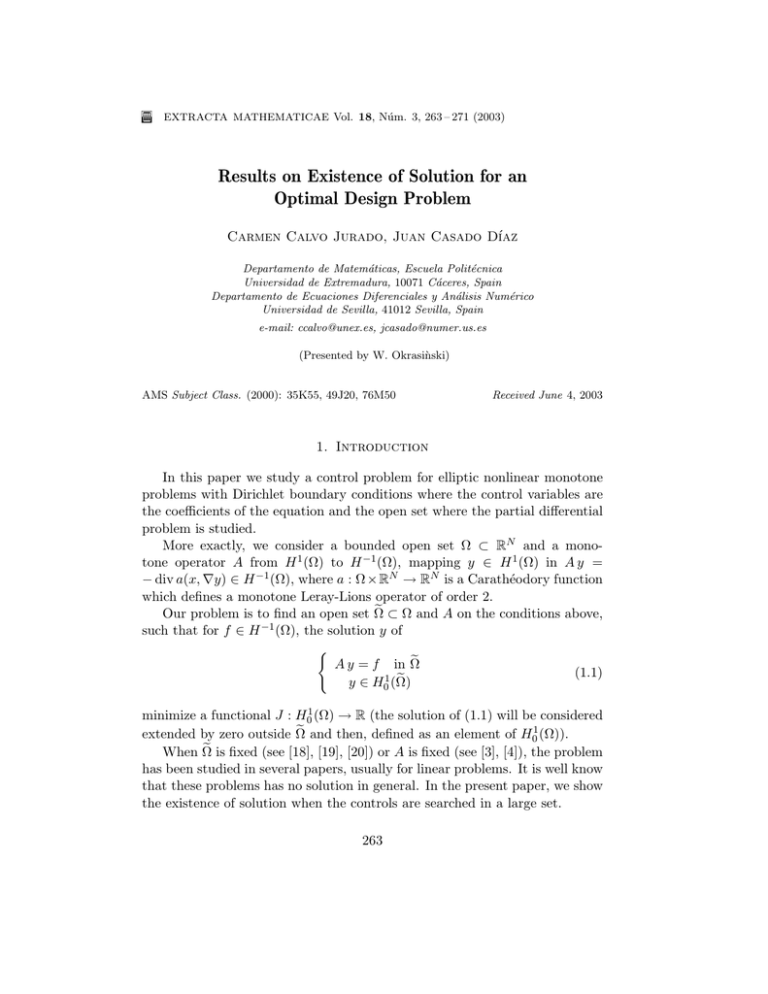
E extracta mathematicae Vol. 18, Núm. 3, 263 – 271 (2003) Results on Existence of Solution for an Optimal Design Problem Carmen Calvo Jurado, Juan Casado Dı́az Departamento de Matemáticas, Escuela Politécnica Universidad de Extremadura, 10071 Cáceres, Spain Departamento de Ecuaciones Diferenciales y Análisis Numérico Universidad de Sevilla, 41012 Sevilla, Spain e-mail: [email protected], [email protected] (Presented by W. Okrasiǹski) AMS Subject Class. (2000): 35K55, 49J20, 76M50 Received June 4, 2003 1. Introduction In this paper we study a control problem for elliptic nonlinear monotone problems with Dirichlet boundary conditions where the control variables are the coefficients of the equation and the open set where the partial differential problem is studied. More exactly, we consider a bounded open set Ω ⊂ RN and a monotone operator A from H 1 (Ω) to H −1 (Ω), mapping y ∈ H 1 (Ω) in A y = − div a(x, ∇y) ∈ H −1 (Ω), where a : Ω × RN → RN is a Carathéodory function which defines a monotone Leray-Lions operator of order 2. e ⊂ Ω and A on the conditions above, Our problem is to find an open set Ω −1 such that for f ∈ H (Ω), the solution y of ( e A y = f in Ω (1.1) 1 e y ∈ H (Ω) 0 minimize a functional J : H01 (Ω) → R (the solution of (1.1) will be considered e and then, defined as an element of H 1 (Ω)). extended by zero outside Ω 0 e is fixed (see [18], [19], [20]) or A is fixed (see [3], [4]), the problem When Ω has been studied in several papers, usually for linear problems. It is well know that these problems has no solution in general. In the present paper, we show the existence of solution when the controls are searched in a large set. 263 264 c. calvo jurado, j. casado dı́az Our results can be generalized to systems of M equations and operators of order p ∈ (1, +∞) (see [5]). Here, by simplicity, we study the scalar case with p = 2. From the point of view of the applications, the results exposed in the present paper are related with the selection of optimal shape material (take into account that the coefficients of the equation depend on the choice of the materials). 2. Notation and preliminaries Let Ω be a bounded open subset of RN . For a measure µ, we denote by the space of the functions which are µ-measurable and have its power two µ-integrable. If µ is the Lebesgue measure, we write Lp (Ω, RM ). We denote by H01 (Ω) the closure of the C ∞ functions with compact support for the norm kukH01 (Ω) = kukL2 (Ω) + k∇ukL2 (Ω)N . The dual space of H01 (Ω), it is denoted by H −1 (Ω). For every subset B ⊂ Ω, and p ∈ (1, +∞), we denote by C(B, Ω) the capacity of B (in Ω), which is defined as the infimum of Z |∇y|2 dx L2µ (Ω), Ω over the set of the functions y ∈ H01 (Ω) such that y ≥ 1 a.e. in a neighbourhood of B. We say that a property P(x) holds C-quasi everywhere (abbreviated as q.e.) in a set E, if there exists N ⊂ E with C(N, Ω) = 0 such that P(x) holds for all x ∈ E\N . A function y : Ω → R is said to be quasi continous, if for every ε > 0 there exists N ⊂ Ω, with C(N, Ω) < ε, such that the restriction of y to Ω\N is continuous. It is well know that every y ∈ H01 (Ω) has a quasi continuous representative (see [15], [16], [24]). We always identify y with its quasi continuous representative. A subset A ⊂ Ω is said to be quasi open in Ω, if for every ε > 0 there exists an open subset U ⊂ Ω, with C(U, Ω) < ε, such that A ∪ N is open. We denote by M20 (Ω) the class of all Borel measures which vanish on the sets of capacity zero and satisfy µ(B) = inf{µ(A) : A quasi open, B ⊆ A ⊆ Ω} for every Borel set B ⊆ Ω. existence of solution 265 Definition 2.1. For α, γ > 0 , we denote by A(α, γ) the set of Carathéodory functions a : Ω × RN → RN such that (i) a(x, 0) = 0 for a.e. x ∈ Ω; (ii) (a(x, ξ1 ) − a(x, ξ2 ))(ξ1 − ξ2 ) ≥ max{α|ξ1 − ξ2 |2 , γ|a(x, ξ1 ) − a(x, ξ2 )|2 } for all ξ1 , ξ2 ∈ RN , a.e. x ∈ Ω. Remark 2.2. If a belongs to A(α, γ), then a satisfies (iii) |a(x, ξ1 ) − a(x, ξ2 )| ≤ 1 |ξ1 − ξ2 | for all ξ1 , ξ2 ∈ R, a.e. x ∈ Ω. γ Reciprocally, if a function a satisfies (a(x, ξ1 ) − a(x, ξ2 ))(ξ1 − ξ2 ) ≥ α|ξ1 − ξ2 |2 for all ξ1 , ξ2 ∈ R, a.e. x ∈ Ω, and there exists β > 0 such that |a(x, ξ1 ) − a(x, ξ2 )| ≤ β|ξ1 − ξ2 | for all ξ1 , ξ2 ∈ R, a.e. x ∈ Ω, then a satisfies (ii) with γ = α . β2 Definition 2.3. We denote by U(α, γ) the set of pairs (µ, F ) such that µ ∈ M20 (Ω) and F : Ω × R → R satisfies (a) F ( · , s) is µ-measurable for very s ∈ R; (b) F (x, 0) = 0, µ-a.e. x ∈ Ω; (c) (F (x, s1 ) − F (x, s2 ))(s1 − s2 ) ≥ max{α|s1 − s2 |2 , γ|F (x, s1 ) − F (x, s2 )|2 } for all s1 , s2 ∈ R, µ-a.e. x ∈ Ω. Remark 2.4. Hypothesis (c) is equivalent to: 1 (s1 − s2 ) ≥ F (x, s1 ) − F (x, s2 ) ≥ α(s1 − s2 ) γ for all s1 , s2 ∈ R, s1 ≥ s2 , µ-a.e. x ∈ Ω. We consider a functional J : H01 (Ω) → R which is sequentially weakly lower semicontinuous, i.e.: yn * y ⇒ lim inf J(yn ) ≥ J(y). n→∞ (2.2) 266 c. calvo jurado, j. casado dı́az 3. Existence of solution for the optimal design problem e ⊂ Ω and a ∈ A , we consider the partial differential For f ∈ H −1 (Ω), Ω problem ( e − div a(x, ∇y) = f in Ω (3.3) 1 e y ∈ H0 (Ω). e and a ∈ A which solve the minimum problem Our purpose is to find Ω ½ min J(y) (3.4) e ⊂ Ω. a ∈ A, Ω In order to show the existence of solution for (3.4), we can try to use the direct method of calculus of variations. For that, we consider Ωn ⊂ Ω opens, and an ∈ A such that the sequence yn of solutions of ½ − div an (x, ∇yn ) = f in Ωn (3.5) yn ∈ H01 (Ωn ) is minimizing, i.e.: lim inf J(yn ) = I n→∞ where e ⊂ Ω, y satisfies (3.3)}. I = inf{J(y) : a ∈ A, Ω Taking yn as test function in (3.5), we deduce Z Z an (x, ∇yn )∇yn dx = f yn dx, Ω Ω which by (ii) implies kf kH −1 (Ω) √ , α where we have identified yn with its extension by zero to Ω\Ωn . So, there exists a subsequence (still denoted by yn ) which converges weakly to a function y in H01 (Ω). By the lower semicontinuity (2.2) of J, we have J(y) ≤ I. If there e ⊂ Ω and a ∈ A such that y satisfies (3.3), then J(y) = I and the exists Ω problem is solved. Therefore, we need to find the equation satisfied by the function y and to know if it is of the same type that (3.3). Thus, we need to study the homogenization problem ½ − div an (x, ∇yn ) = f in D0 (Ωn ) (3.6) yn ∈ H01 (Ωn ), kyn kH01 (Ω) ≤ existence of solution 267 where an ∈ A and Ωn is a sequence of arbitrary open sets contained in a given bounded open set Ω ⊂ RN . This is a question which is well known when Ωn or an is fixed. When Ωn is fixed it has been proved (see for example [21], for the linear problem and [22], [23] for the nonlinear one) that there exists a function a ∈ A e fixed, converge such that (for a sequence) the solutions yn of (3.6) with Ωn = Ω 1 weakly in H0 (Ω) to the solution y of ( e − div a(x, ∇y) = f in Ω 1 e y ∈ H (Ω), 0 where a does not depend of f . In particular, this implies that the initial e is not variable (control problem (3.4), has a solution if we assume that Ω coefficients problem). However, when an is fixed, it is not true in general that there exists a e ⊂ Ω such that the subsequence of Ωn , still denoted by Ωn , and open set Ω solutions of (3.6) with an = a fixed, converge weakly in H01 (Ω) to the solution y of ( e − div a(x, ∇y) = f in D0 (Ω) 1 e y ∈ H0 (Ω). S For example, if N = 3, and Ωn = Ω\ k∈ZN B( nk , n13 ), it has been proved in [8], that the sequence of solutions yn of (3.6) with a(x, ξ) = ξ, for all ξ ∈ R, a.e. x ∈ Ω, (laplacian operator) converges weakly in H01 (Ω) to the unique solution y of ½ in Ω −∆ y + 4π 3 y =f (3.7) y ∈ H01 (Ω). As a consequence of this result, let us now prove Theorem 3.1. The problem (3.4) has no solution in general. Proof. Let Ω ⊂ RN be a bounded open set. We respectively denote by y0 the solution of (3.7) with f = 1 and by ȳ the solution of ½ −∆ȳ = 1 in Ω (3.8) ȳ ∈ H01 (Ω). R We consider J : H01 (Ω) → R as J(y) = Ω |y − y0 |2 dy, for all y ∈ H01 (Ω) and 1 α = 1 − ε, γ = 1+ε , with ε small enough such that µ 2 ¶2 Z Z ε + 4ε |∇ȳ|2 dy < |∇(ȳ − y0 )|2 dy. (3.9) 1−ε Ω Ω 268 c. calvo jurado, j. casado dı́az Remark that yn * y in H01 (Ω) implies J(yn ) → J(y) in R. It is clear for the result of Cianorescu-Murat mentioned above, that in this e solution of (3.4), then case I = 0. So, if there exists (a, Ω) ( e − div a(x, ∇y0 ) = 1 in Ω e y0 ∈ H01 (Ω). e implies that y0 = 0 q.e. in Ω\Ω, e but the strong maximum Now, y0 ∈ H01 (Ω), e has capacity zero, but then H 1 (Ω) principle implies that y0 > 0 in Ω. So, Ω\Ω 0 1 e and y0 is also the solution of the problem is equal to H0 (Ω), ½ − div a(x, ∇y0 ) = 1 in Ω (3.10) y0 ∈ H01 (Ω). On the other hand, by (ii), for every ξ ∈ RN and a.e. x ∈ Ω, we have |ξ − a(x, ξ)| = |ξ|2 + |a(x, ξ)|2 − 2a(x, ξ)ξ ≤ |ξ|2 + (1 + ε)2 |ξ|2 − 2(1 − ε)|ξ|2 = (4ε + ε2 )|ξ|2 . (3.11) Taking y0 − ȳ as test function in the difference of (3.8) and (3.10), we deduce Z [a(x, ∇y0 ) − ∇ȳ]∇(y0 − ȳ) dy = 0, Ω and then, using (ii) and (iii), we obtain Z Z 2 (1 − ε) |∇(y0 − ȳ)| dy ≤ [a(x, ∇y0 ) − a(x, ∇ȳ)]∇(y0 − ȳ) dy Ω ZΩ ≤ [∇ȳ − a(x, ∇ȳ)]∇(y0 − ȳ) dy (3.12) Ω ¶1 µZ ¶ 1 µZ 2 2 2 2 ≤ (4ε + ε ) |∇ȳ| dy |∇(y0 − ȳ)| dy . 2 Ω Ω From (3.9) and (3.12) we deduce the absurd. Our interest in the following is to show that the control problem has a solution if we search for the control variables in a more large set. For this purpose, following G. Dal Maso and U. Mosco (see [11]), we remark that e ⊂ Ω open, the measure µ ∈ M2 (Ω) as defining for Ω 0 ( e ∩ B) = 0 0 if cap((Ω\Ω) µ(B) = e ∩ B) > 0, +∞ if cap((Ω\Ω) existence of solution 269 and taking F , such that the pair (µ, F ) belongs to U(α, γ) (it always exists) the problem (3.3) is equivalent to the variational problem y ∈ H01 (Ω) ∩ L2µ (Ω) Z Z a(x, ∇y)∇v dx + F (x, y)v dµ = hf, vi (3.13) Ω Ω ∀v ∈ H01 (Ω) ∩ L2µ (Ω) Then, at the place of the original control problem, we can consider the following one min{J(y) : a ∈ A(α, γ), (F, µ) ∈ U(α, γ)}, (3.14) where for A(α, γ), (F, µ) ∈ U(α, γ), y is the unique solution of (3.13). The advantage of the new formulation is clear from the following theorem. Theorem 3.2. For every sequences an in A(α, γ) and (Fn , µn ) in U(α, γ), there exists a subsequence, still denoted by n, such that for every f ∈ H −1 (Ω), the solution yn of yn ∈ H01 (Ω) ∩ ∩ L2µn (Ω) Z Z an (x, ∇yn )∇v dx + Fn (x, yn )v dµn = hf, vi (3.15) Ω Ω ∀v ∈ H01 (Ω) ∩ ∩ L2µn (Ω) converges weakly in H01 (Ω) to the solution y of (3.13). Theorem 3.2 has been proved by the authors in [5], in fact it is true for operators of order p ∈ (1, +∞) and for systems. In particular, it gives the form of the limit problem of (3.6) for arbitrary Ωn and an . When µn is zero for every n, the result can be found in [22] and [23]. For the case an constant, the theorem has been shown in [7], although it is not proved that the pair (F, µ) which appears in the limit problem is in U(α, γ) (see also [6], [8], [9], [10], [11], [12], . . . ). When an and Fn are linear, the result appears in [14]. For the double homogenization problem, with monotone operators, a previous result has been proved in [17], but in this work µn are not general, they correspond to a sequence of open sets Ωn , such that the measure µ in the limit is the Lebesgue measure. Using Theorem 3.2, we can now apply the direct method of the calculus of variations as above to prove 270 c. calvo jurado, j. casado dı́az Theorem 3.3. The problem (3.14) admits at least a solution a ∈ A(α, γ), (F, µ) ∈ U(α, γ). The question which remains is to know if the problem (3.15) is a relaxation of (3.4), i.e., if for every a ∈ A(α, γ) and (F, µ) ∈ U(α, γ), there exists an ∈ A and Ωn ⊂ Ω open, such that the solutions yn of (3.6) converge weakly in H01 (Ω) to the solution y of (3.13). This is true if we ask for the elements of A and U to be linear in its second variable (see [14]). Acknowledgements This paper has been partially supported by the project PB98-1162 of the D.G.E.S.I.C. of Spain. References [1] Boccardo, L., Murat, F., Almost everywhere convergence of the gradi[2] [3] [4] [5] [6] [7] [8] [9] [10] ents of solutions to elliptic and parabolic equations, Nonlinear Anal. Theor. Math. Appl. 19 (6) (1992), 581 – 597. Braides, A., Malusa, A., Approximation of relaxed Dirichlet problems, in “Calculus of Variations, Homogenization and Continuum Mechanics”, Marseille, 1993, 83 – 97. (Ser. Adv. Math. Appl. Sci. 18, World Sci., River Edge, 1994.) Buttazzo, G., Dal Maso, G., Shape optimization for Dirichlet problems. Relaxed SIS and optimaly conditions, Appl. Math. Optim. 23 (1991), 17 – 49. Buttazzo, G., Dal Maso, G., Garroni, A., Malusa, A., On the relaxed formulation of some shape optimization problems, Adv. Math. Sci. Appl. 7 (1) (1997), 1 – 24. Calvo-Jurado, C., Casado-Díaz, J., The limit of Dirichlet systems for variable monotone operators in general perforated domains, J. Math. Pures Appl. 81 (2002), 471 – 493. Casado-Díaz, J., Homogenisation of Dirichlet problems for monotone operators in varying domains, Proc. Roy. Soc. Edinburgh Sect. A 127 (1997), 457 – 478. Casado-Díaz, J., Garroni, A., Asymptotic behaviour of nonlinear elliptic systems on varying domains, SIAM J. Anal. Math. 31 (3) (2000), 249 – 276. Cionarescu, D., Murat, F., Un terme étrange venu d’ailleurs, in “Nonlinear Partial Differential Equations and their Applications”, Collège de France Seminar, Vols II and III, 98 – 138 and 154 – 78 (Ed. by H. Brézis and J.L. Lions, Research Notes in Math. 60 and 70, Pitman, London, 1982.) Dal Maso, G., Defranceschi, A., Limits of nonlinear Dirichlet problems in varying domains, Manuscripta Math. 61 (1988), 251 – 278. Dal Maso, G., Garroni, A., New results on the assymptotic behaviour of Dirichlet problems in perforated domains, Math. Models Meth. Appl. Sci. 3 (1994), 373 – 407. existence of solution 271 [11] Dal Maso, G., Mosco, U., Wiener-criterion and Γ-convergence, Appl. Math. Optim. 15 (1987), 15 – 63. [12] Dal Maso, G., Murat, F., Asymptotic behaviour and correctors for Di[13] [14] [15] [16] [17] [18] [19] [20] [21] [22] [23] [24] richlet problems in perforated domains with homogeneous monotone operators, Ann. Sc. Norm. Sup. Pisa 7 (4) (1997), 765 – 803. Dal Maso, G., Murat, F., Almost everywhere convergence of gradients of solutions to nonlinear elliptic systems, Nonlinear Anal. Serie A 31 (3/4) (1998), 405-412. Dal Maso, G., Murat, F., Asymptotic behaviour and correctors for linear Dirichlet problems with simultaneously varying operators and domains (to appear). Evans, L.C., Gariepy, R.F., “Measure Theory and Fine Properties of Functions”, CRC Press, Boca Raton, 1992. Federer, H., Ziemer, W.P., The Lebesgue set of a function whose distribution derivaties are p-th power sumable, Indiana Univ. Math. J. 22 (1972), 139 – 158. Kovalevsky, A., An effect of double homogenization for Dirichlet problems in variable domains of general structure, C.R. Acad. Sci. Paris Ser. I 328 (1999), 1151 – 1156. Lurie, K.A., “Applied Optimal Control Theory of Distributed Systems”, Plenum Press, New York, 1993. Murat, F., Théorèmes de non-existence pour des problèmes de contrôle dans le coefficients, C.R. Acad. Sci. Paris Ser. A 274 (1972), 395 – 398. Murat, F., Tartar, L., On the control of coefficientes in partial differential equations, in “Topics in the Mathematical Modelling of Composite Materials” (Ed. by A. Cherkaek, R. Kohn, Progress in Nonlinear Differential Equations and their Appl., Birkhäuser, Boston, 1997), 139 – 173. Murat, F., Tartar, L., H-convergence, in “Topics in the Mathematical Modelling of Composite Materials”, Ed. by A. Cherkaev, R. Kohn, Progress in Nonlinear Differential Equations and their Applications (Birkäuser, Boston, 1997) 21 – 43. Pankov, A., “G-Convergence and Homogenization of Nonlinear Partial Differential Operators”, Math. and its Appl. 422, Kluwer Academic Publishers, London, 1997. del Vecchio, T., On the homogenization in a class of pseudomonotone operators in divergence form, Boll. Unione Mat. Ital. B (7) 5 (2) (1991), 369 – 388. Ziemer, W.P., “Weakly Differentiable Functions”, Springer-Verlag, Berlin, 1989.
